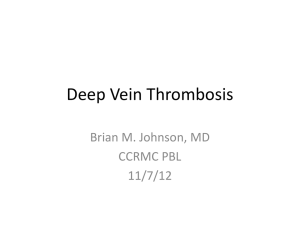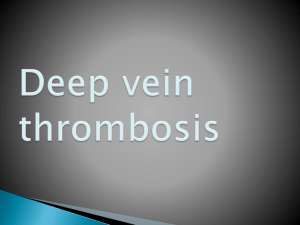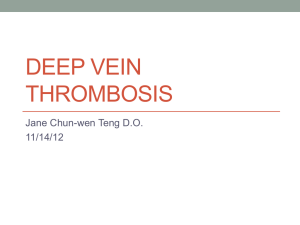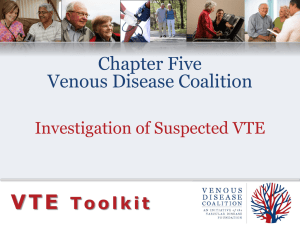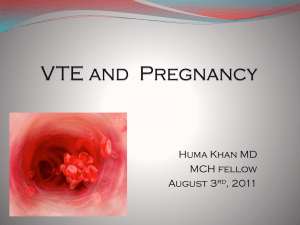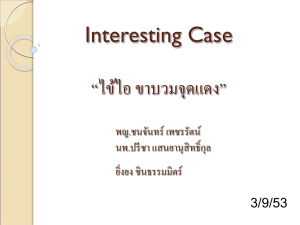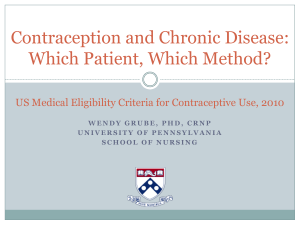Venous Thromboembolism (VTE) The Patient Journey
advertisement
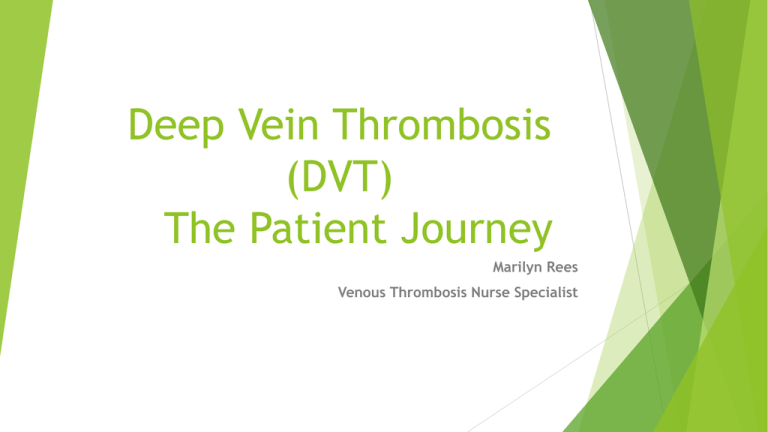
Deep Vein Thrombosis (DVT) The Patient Journey Marilyn Rees Venous Thrombosis Nurse Specialist Overview Diagnosis Goals of DVT of treatment Challenges Case Quiz of DVT Treatment studies Clinical Diagnosis of DVT • DVT symptoms can be nonspecific, making it difficult to diagnose. • Presence of DVT risk factors increase the likelihood of having the disease • Objective testing must be used to confirm or rule out suspicion Approaches to Diagnosis of DVT • • • • • Patient History Clinical Symptoms and Signs Clinical Probability Score Laboratory Testing Imaging Testing Clinical Signs and Symptoms of DVT (Nonsurgical Patients) • Leg pain (90%) • Tenderness (85%) • Ankle oedema (76%) • Calf swelling (42%) • Dilated veins (33%) • Homan’s sign (33%) (sharp pain in the calf on dorsiflexion of the foot) Reference Haeger K. Problems of acute deep venous thrombosis. I. The interpretation of signs and symptoms. Angiology. 1969;20:219223. Clinical Signs and Symptoms of DVT (cont’d) • DVT cannot be reliably diagnosed on the basis of history and physical exam, even in high-risk patients. • Patients with lower extremity DVT often do not exhibit erythema, warmth, swelling, or tenderness (Symptoms in surgical patients are often masked by common post- operative pain and limb swelling) • When present, these findings merit further evaluation despite lack of specificity Diagnostic Algorithms • Clinical diagnosis of DVT is non-specific because none of the signs in isolation are particular to the disease • In symptomatic patients, clinical pre-test models can be used to determine probability of DVT or PE Wells Scoring System for Diagnosing DVT Clinical Characteristic Score* Active cancer (treatment ongoing, within, 6 months or palliative) 1 Paralysis, paresis, or recent plaster immobilization of the lower extremity 1 Bedridden for >3 days or major surgery with general/regional anaesthesia within previous 12 weeks 1 Localized tenderness along the distribution of the deep venous system 1 Entire leg swollen 1 Calf swelling 3 cm larger than asymptomatic side (measured 10 cm below tibial tuberosity) 1 Pitting oedema confined to symptomatic leg 1 Collateral superficial veins (non-varicose) 1 Previous documented DVT 1 Alternative diagnosis at least as likely as DVT e.g (Popliteal (Baker) cyst, superficial thrombophlebitis, muscle pulls/tears, chronic venous insufficiency, and others) -2 Clinical probability simplified score DVT likely 2 points or more DVT unlikely 1 point or less Alternative Diagnosis VTE Investigations Laboratory •D Dimer (degradation product of a crosslinked fibrin blood clot) D-dimer has a high false-positive rate Sensitive but nonspecific also increased in other conditions: cancer, inflammation, postoperatively, injury, pregnancy. Non-invasive testing Doppler Compression Ultrasound Non-invasive, no contraindications. High accuracy in symptomatic patients (91%) Venous system in lower limbs PROXIMAL VEINS DISTAL VEINS Suspected Leg Deep Vein Thrombosis Well’s score UNLIKELY probability Well’s score LIKELY probability D-DIMER -ve NO DVT Patient discharged back to referrer -ve Full leg Ultrasound +ve +ve NO DVT Full leg Ultrasound +ve -ve Deep Vein Thrombosis Patient discharged back to referrer What happens next? Four Goals of VTE Treatment 1.Prevent fatal PE 2.Reduce morbidity associated with acute leg or lung thrombus 3.Prevent recurrent VTE 4.Prevent long-term sequelae DVT Confirmed 1.Full medical assessment to consider underlying pathology including breast examination in women over 30yrs of age and rectal examination if indicated by symptoms. 2. If pv examination is necessary this will be highlighted in the discharge letter as the DVT clinic is not a suitable environment for this to occur. 3. Full blood screen including : FBC, Ferritin, U+E/ eGFR, LFT, Baseline Coag and INR, Bone profile, Urine dipstick (and Pregnancy test in women of child bearing age) CXR in unprovoked DVT PSA if required (following PR examination/if prostatic symptoms) Tumour markers if abdominal symptoms/signs. Malignancy 10% Unprovoked DVT / PE present with cancer within 1 year A Presenting sign in: Pancreatic cancer Prostate cancer Late sign in: Breast cancer Lung cancer Uterine cancer Brain cancer Investigations for cancer Offer all patients diagnosed with unprovoked DVT or PE who are not already known to have cancer the following investigations for cancer: a physical examination (guided by the patient's full history) and a chest X-ray and blood tests (full blood count, serum calcium and liver function tests) and urinalysis. Consider Further investigations for cancer with an abdomino-pelvic CT scan (and a mammogram for women) in all patients aged over 40 years with a first unprovoked DVT or PE who do not have signs or symptoms of cancer based on initial investigation (see 'Investigations for cancer' above). Two Phases of VTE Management Initial Treatment Long-term treatment • ≥5 d treatment with SC • Necessary for patients at continuous risk for recurrence • Duration of treatment is dependent on underlying disease and risk factors • Appropriate treatment can reduce the risk of recurrence to approximately 5% at 3 months LMWH or IV UFH, • Discontinue when INR >2.0 for 48 hr • Initiation of VKA together with LMWH or UFH on first treatment day Or Initiation with New Oral Anticoagulant (Rivaroxaban) TIME 1st Precipitated DVT □ 1st idiopathic DVT □ Recurrent DVT □ Surgery past 12 weeks Lower limb fracture Lower limb in plaster Pregnant Post partum up to 12 weeks (Travel / COCP / HRT) Distal DVT (below knee) □ Proximal DVT (above knee) □ Distal DVT (below knee) □ Proximal DVT (above knee) □ Anticoagulate Anticoagulate 3 months □ 3 months □ Refer to ART (if suitable) □ Refer to ART (if suitable) □ If no family history DVT / PE Discharge at end of treatment □ Thrombosis Clinic If family history DVT / PE □ Follow up at 3 months □ Traditional approaches of Anticoagulation Heparin Minimum of 5 days Until INR > 2 on at least 2 occasions Warfarin PE minimum 3 months Idiopathic proximal DVT minimum 3 months Idiopathic distal DVT 3 months Provoked distal DVT 3 months Recurrent DVT / PE long term New approaches to anticoagulation Vitamin K antagonists (VKAs) and ODIs VKA VII TF VIIa Initiation VKA X IX Propagation IXa Xa VKA II RIVAROXABAN Inactive factor APIXABAN Active factor EDOXABAN Transformation IIa Catalysis Clot formation Fibrinogen DABIGATRAN Fibrin OUT-PATIENT TREATMENT OF DVT Low molecular weight heparin •Enoxaparin should be continued until the INR has been >2 for 2 consecutive days and for a minimum of 5 days. Warfarin •If the initial PT is <17s (INR <1.3) the patient will receive 5mg of warfarin on the evenings (17:00 to 19:00) of days 1 and 2. •The INR is checked on the mornings of day 3 and 4 and the warfarin dose is adjusted according to the schedule: If the patient is on an anti-platelet medication a doctor should review whether this is to continue, whilst the patient is on warfarin. Indication Target INR (+/- 0.5) Duration Follow up 1st idiopathic proximal DVT 2.5 ≥ 3 months Thrombosis Clinic 1st precipitated proximal DVT 2.5 3 months *No follow up 1st idiopathic distal DVT 2.5 3 months *No follow up 1st precipitated distal DVT 2.5 3 months *No follow up Recurrent DVT not on warfarin / subtherapeutic INR 2.5 ≥ 3 months Thrombosis Clinic Recurrent DVT on warfarin and therapeutic INR 3.5 Long-term Thrombosis Clinic Day 1 and 2 Warfarin 5mg each day Day 3 Day 4 INR Dose INR Dose < 1.5 1.5-2.0 2.1-2.5 2.6-3.0 >3.0 10 mg 5 mg 3 mg 1 mg 0 mg < 1.6 1.6-1.7 1.8-1.9 2.0-2.3 2.4-2.7 2.8-3.0 3.1-3.5 3.6-4.0 >4.0 10 mg 7 mg 6 mg 5 mg 4 mg 3 mg 2 mg 1 mg 0 mg Rivaroxaban as an alternative to warfarin •Patients who have suffered a 1st precipitated DVT and only require 3 months anticoagulation will be offered the option of warfarin or rivaroxaban •Patients with a history of excessive alcohol consumption, in whom warfarin and INR monitoring will be difficult will be offered the option of LMWH or rivaroxaban •Patients with poor venous access e.g. history of IVDU will be offered the option of LMWH or rivaroxaban First 3 weeks Subsequent 9 weeks Rivaroxaban 15mg bd Rivaroxaban 20mg od Treatment options for Venous Thromboembolism in patients with solid tumours Shared agreement between Bro Taf and Cardiff and Vale Extended treatment with Dalteparin for up to 6 months Prescribe Dalteparin at approximately 200 iu/ kg total body weight subcutaneously once daily for the first 30days Months 2-6 Dalteparin should be administered at a dose of approxiamtely 150 iu/kg s/c once daily Recommended treatment is 6 months. Continuing beyond this period will be evaluated according to individuals risk/benefits and progression of cancer Treat for 3 months and reassess Isolated distal DVT Stop at 3 months Reversible provoking factor Stop at 3 months Unprovoked proximal DVT or PE Review options Cancer Indefinite therapy or until cancer inactive High Bleeding Risk OR Prefers to stop even if D Dimer positive Others Stop and measure D Dimer at 1 month Not High Bleeding Risk and prefers to stay on even if D Dimer is negative Second VTE Negative D Dimer Stay off therapy (Stop at 3 months) Positive D Dimer Restart therapy (Indefinite therapy) Indefinite therapy TAKE 100 ASYMPTOMATIC CALF DVT 16%-20% of them become proximal Half of these will embolise i.e.8%-10% Half of these will be symptomatic PE ( i.e. 4%-5% or PE’s) Untreated PE (1.0% of the total) symptomatic and non-fatal –26% (1.0% of the total) will be fatal PE. TAKE 100 SYMPTOMATIC CALF DVT 100 symptomatic DVT 21%-36% of them become proximal Half of these will embolisei.e.8%-18% Half of these will be symptomatic PE (ie4%-9% or PE’s) Untreated PE –26% (1.5% of the total) symptomatic and non-fatal –26% (1.5% of the total) will be fatal PE. Cohen AT, JTH 2006 Case History 1 48yr old male Presenting with 4/52 history of ‘sciatic’ type lower back pain radiating down left leg. No past medical history but awaiting private gastro-enterologist review for ‘epigastric’ type pain and MRI for back pain Wells score – 2 ( Calf >3cms, pitting oedema unilaterally) • Doppler Ultrasound – Gastrocnemius vein clot (not extending into popliteal vein) • Re-scanned in 1/52 – Gastrocnemius clot extended into popliteal ven • Initial treatment with LMWH whilst awaiting result of MRI • Urgent CT Chest, abdo and pelvis • Malignant sacral bone lesion with widespread retroperitoneal and thoracic small volume tissue deposits • Plan – Admission – Biopsy • Management of DVT – insertion of IVC filter • Anti-coagulation – determined following biopsy result. Case history 2 63yr old female Presenting with one day history of calf pain History of 7hr car journey plus 31/2hr flight Lower leg feeling ‘itchy’ PMH – Asthma Wells Score 1 D Dimer +ve Doppler Ultrasound – Left Tibial DVT Treatment choice – Rivaroxaban No follow up Case history 3 83yr old female 5/52 history of painful/ swollen left leg Initially treated by GP as cellulitis with antibiotics No response after 2/52 Doppler ultrasound – Left ileo-femoral DVT No provoking factors other than age and limited mobility (chronic) No red flags Plan Warfarin/LMWH Review at 3/12 Clot Quiz DVT? Or something else……… One Final Point Why you should ask about clots Blood clots can happen to anyone. If you are in hospital – or have left hospital in the last three months – you are at greater risk of developing a clot. Blood clots are preventable! Ask your doctor, nurse or healthcare professional to help you reduce your risk of developing a clot. Watch the video to find out more http://www.youtube.com/watch?v=TVKIyy9dcKc Thank You The venous return from your leg has now slowed by 50%. Please ensure you have re-established sufficient flow before the next speaker to reduce your risk of a (potentially fatal) VTE.
